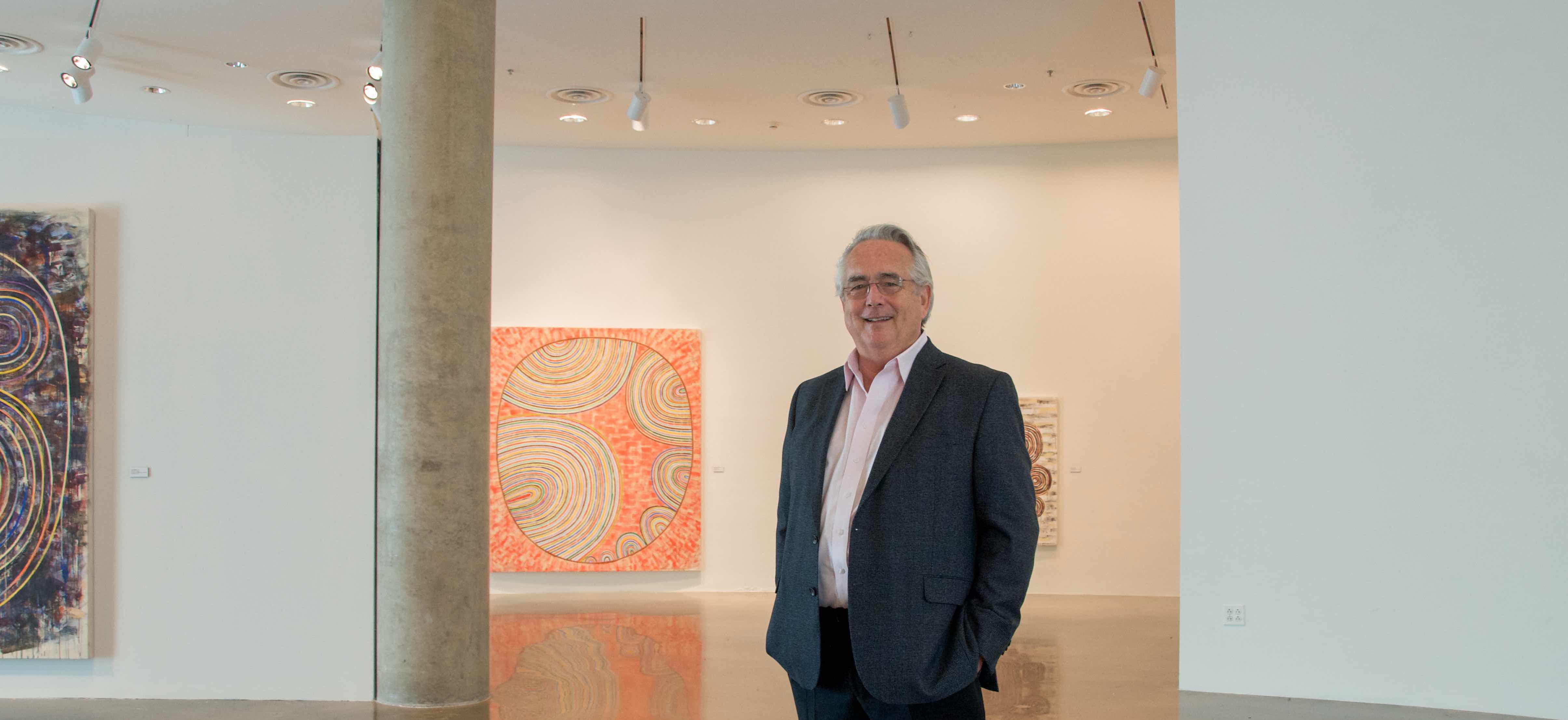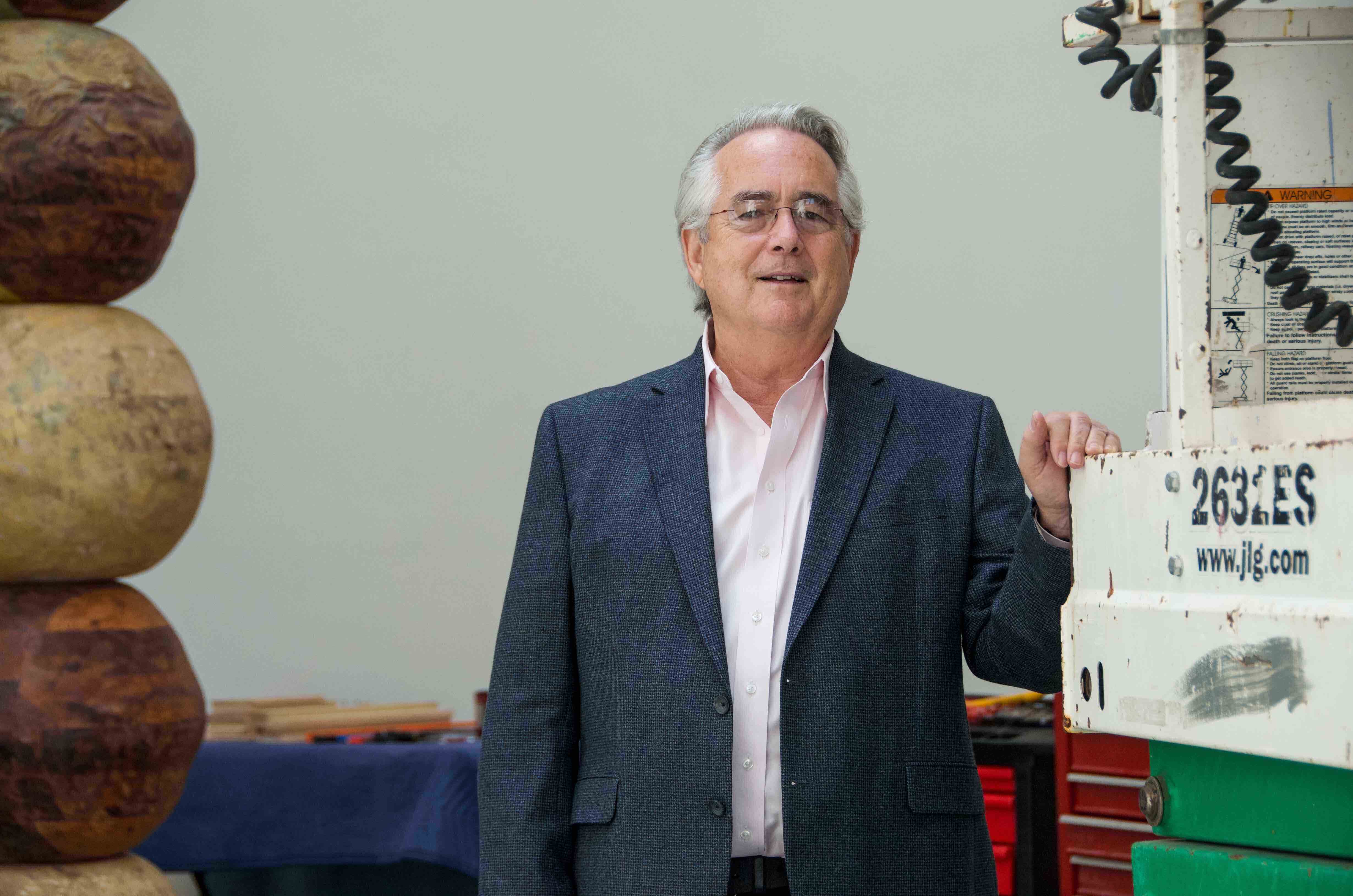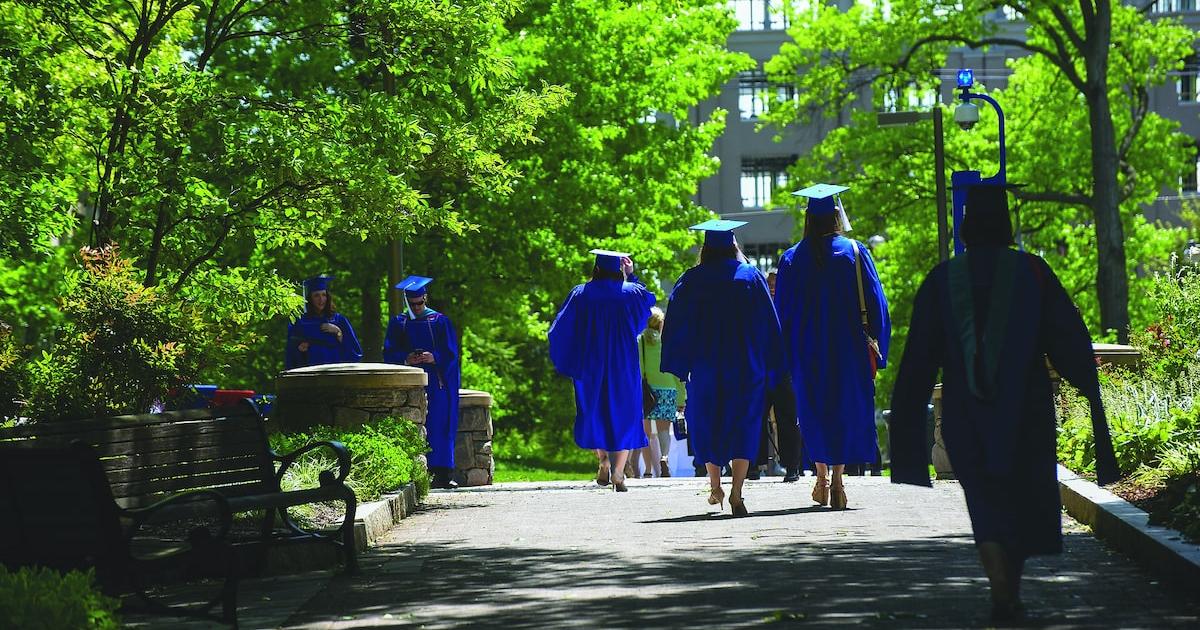
On most days, Jack Rasmussen, CAS/MFA ’75, MA ’83, PhD ’94, can be found surrounded by art. His daily rounds as the American University Museum Director and Curator take him across three floors of rotating exhibitions, winding past paintings, sculptures, and artworks of all media. He knows nearly every inch of the museum by heart.
Rasmussen has led the AU Museum since 2005. An artist by training and repeat Eagle, he remains as passionate about the museum’s mission as the day he started. 2023 marks his 18th year at the helm and his first as the inaugural C. Nicholas Keating and Carleen B. Keating Director.
The newly endowed directorship is made possible by a Change Can’t Wait campaign gift and furthers the Keating legacy at the AU Museum.
Both devoted art collectors, Nick Keating, SIS/BA ’63, MA ‘64, and Carleen Keating, CAS/BA ’64, shared a commitment to the arts at their alma mater. The directorship, named by Carleen in memory of her late husband, comes alongside a donation of the couple’s private art collection.
“The AU Museum has long been an artistic home for AU and for DC,” says Carleen Keating. “Under Jack Rasmussen’s leadership, the museum has charted an ambitious course with clarity of vision and attention to community needs. It is deeply meaningful to me that the Keating Directorship and Collection will continue this important work.”
For Rasmussen, the endowed directorship is a testament to the AU Museum’s inspiring growth over the past decades. Longtime friends, he and Carleen Keating served together on the planning committee for the Katzen Arts Center during its development in the early 2000s. Rasmussen sees the gift’s meaning as twofold—both a commemoration of personal friendship and a sustaining pillar of museum support for years to come.
“The exciting thing for me,” Rasmussen says, “is that the [Director] position will be institutionalized. . . . It’s wonderful that it's pretty much assured that they're going to have solid leadership here [at the AU Museum] and a strong artistic direction.”
He adds, “It's also very satisfying to me because I wouldn't be here if it weren’t for Carleen Keating.”
A Museum for DC
The endowed position underscores the AU Museum’s cultural significance to the university and the wider DC region.
Overlooking Ward Circle at the top of Embassy Row, the museum forms the northern cornerstone of the Katzen Arts Center and is part of the College of Arts and Sciences. Katzen is the artistic epicenter of AU. Multidisciplinary in design and practice, it houses the university’s visual and performing arts programs.
Of Katzen’s 130,000 sq feet, the AU Museum boasts an extraordinary 24,000. It is an arrestingly beautiful space. In the morning, natural light illuminates the space through the large glass windows and skylight. At night, the circular framing and ceiling play perfect host to evening concerts.
If these features—natural light and curved walls—seem to challenge conventional rules in art curation, it’s not coincidental. Distinction is a pride point for the AU Museum. In a city brimming with museums and galleries, the AU Museum sets itself apart as the region’s largest university facility and DC’s only academic public-facing museum. A place where art is global, political, and supportive of local artists.
In other words, Rasmussen says, a DC museum that is for DC.
“We’re always trying to figure out ways to ‘open it up’ and counter the [establishment] canon of Washington art,” explains Rasmussen. “We’re devoted to the Washington community even as we focus on our international neighbors.”
Rasmussen points to the history of the AU Museum for insight into how its current priorities took shape.
In the years following World War II, the museum’s Watkins Memorial Collection was established and shepherded by titans of the art world, most notably Duncan Phillips. Through gifts from the Katherine Drier Collection and Marcel Duchamp, what was primarily an internal educational collection for AU painting students (what Rasmussen calls a “teaching closet”) grew to include premiere artworks by Marc Chagall, Paul Klee, Tintoretto, and Rembrandt.
Decades later, rising real estate prices fueled a DC-wide shortage of gathering spaces for artists. As galleries in the city’s creative cores shuttered en masse, first on P and R Streets in the 1980s and then on downtown Seventh Street two decades later, artists, curators, and collectors were left without a means to convene. Exhibition openings at the AU Museum quickly took on new importance for the artistic community to come together.
The most recent flashpoint came with the closure of the Corcoran Gallery of Art in 2014. When the Corcoran collection was reallocated to universities in DC in 2018, the AU Museum was gifted 9,000 significant works valued at over $34 million, doubling its catalogue. The AU Museum witnessed its profile soar. Here once again was a museum with the capacity to safeguard cultural treasures and host public audiences.
“When [DC community members] lost the Corcoran Gallery of Art, they lost the center,” says Rasmussen.
“One of the things I like to say,” he continues, “is that our success has come from picking up pieces that fell off of the Corcoran. We have a really, really valuable function in the city.”
Centering Relevancy
Today, three exhibition cycles each year feature a mix of artists and media, with dedicated efforts—such as the Alper Initative for Washington Art and the Project Space for interdisciplinary work at AU—ensuring a dynamic intersection of viewpoints.
Political and social themes inform the AU Museum’s work. Per the museum’s philosophy statement, AU’s commitment to “human rights, social justice, and political engagement” is centered in every exhibition. Current and past seasons have included a photo series on rural Ukraine, the first Aboriginal-led exhibition of bark painting by the Yolŋu people, and an artwork-poetry collaboration about war and exile by Ethiopian artist Kebedech Tekleab and DC poet E. Ethelbert Miller.
The museum’s focus on issues such as race, gender, and violence is embedded in its mission.
“I really built the mission of the [AU Museum] around A: the strengths and mission of the university, and B: what other museums were not doing,” Rasmussen says. “A lot of local museums do not show local or international contemporary art. Most local museums run from anything to do with politics.”
He explains that AU’s character is a natural springboard for socially conscious curation.
“We have been the number-one-ranking politically involved campus by The Princeton Review. It's a badge of courage,” says Rasmussen. “It’s the fabric of what we do on this path, whether it's featuring artists of color and women, or challenging the perceived view of Washington art history.”
Looking toward the future, the AU Museum is focused on expanding opportunities for AU faculty and students. Admission to the museum is always free, and students can take classes on curatorial practice where they create their own art shows. Rasmussen and museum leadership hope to bring on an academic curator to work directly with professors to embed exhibition visits into syllabus planning. They’re also in the process of making the 16,000-piece collection accessible online.
Rasmussen frames these efforts as a revival of the museum’s origins. While the days of professors taking their classes into the “teaching closet” of the Watkins Building are long gone, he says the AU Museum’s strategic plan “points the way towards a more robust relationship with the university.”

In Rasmussen’s view, the Keating Directorship furthers this goal by cementing investment in museum leadership. Having watched the AU Museum evolve throughout his tenure, he remains the museum’s most resolute advocate. His passion, he shares, comes from a place of love for the work.
“I've often said that real happiness is if you have a job where it's what you're good at and what you love to do,” reflects Rasmussen. “And that's the point for me—I love working with people and organizing and promoting and talking, but I'm also deeply involved in the artistic process.”
The AU Museum is the better for it. Across its expansive catalogue, dedication is a throughline. The story of the AU Museum continues to be one of reverent opportunism, made possible by the people—from donors such as the Keatings and leaders like Rasmussen—who know its worth firsthand and proudly champion it.




